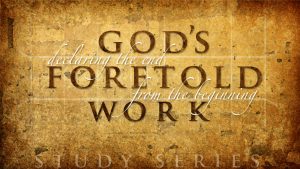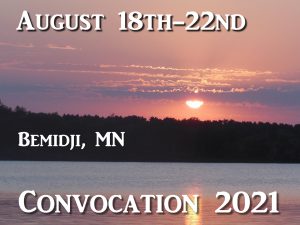We are dealing with much that the Holy Spirit has pressed upon our hearts concerning the Time of Jacob’s Trouble. Perhaps I’m the same as many before me, but I just can’t see the Tribulation being more than a couple of decades away at most.
I agree. Although there are obstacles that for the moment stand in the way of final fulfillment, what is that to God? Look at the obstacles that made where we are today seem completely for over nineteen centuries until the Jewish resettlement of Israel, so that the tendency was always strong to spiritualize prophecy.
When I look at the language of such prophecies as Ezek 38:8 and Zeph 2:1-2, it apparent that a preliminary return of the Jews to the Land in unbelief has only lately occurred when the invader from the north takes notice of the revived prosperity of the land. Notably, this return comes before the final redemption, but ‘after’ what is presented as a ‘recent’ ingathering from an age long dispersal (“brought back from the sword after many years”). Yet, this return is just as clearly ‘before’ the last war that ends with Israel’s national deliverance and regeneration (Ezek 39:9-29). Notice that the invasion comes at a time of security (Ez 38:8, 11, 14; 39:26). What kind of ‘security’ is this?
Some interpreters claim that this invasion comes when Israel is dwelling securely in the millennium. But this cannot be for two clear reasons: First, Israel is not saved until AFTER the invasion. Secondly, Ezek 39:26 shows that Israel’s transgressions continue to multiply during this time of security, whereas the scripture is clear that millennial Israel never again lapses (Jer 31:34; 32:40; Isa 54:13; 59:21; 60:21; 65:23; 66:22 et al). It is therefore manifestly a ‘false security’ that is in view.
Other passages reveal that Israel enters into a delusive league with the Antichrist (Isa 28:15, 18; Dan 9:27; 11:23). Scripture says he “destroys many by peace” (Dan 8:25). This ultimate vanity on the part of Israel is embodied in the ill-fated declaration of “peace and safety” (1Thes 5:3). It is telling that when Paul wishes to describe conditions that precede the day of the Lord, he employs the same language that the prophets use to describe the time ‘Jacob’s trouble’ or ‘Zion’s travail’ (Isa 13:8; 66:8; Jer 30:7: Mic 5:3). Doubtless, Paul has this in mind.
Everything in the modern political world is geared toward the achievement of this peace. Though currently quite elusive, it will come! But while the world will rejoice at the bright new prospect of peace in the Middle East, the true church will be sounding a prophetic warning of woe to all who embrace such a foolish presumption. What will appear for the moment to be Judaism’s greatest triumph since the destruction of the second temple will end in sudden destruction (compare Isa 28:15, 18 with Jer 30:7; Dan 12:1; Mt 24:21). The church needs to prepare itself in order to be to be a faithful witness to Israel concerning the meaning of these events in relation to the gospel of Christ. The present Sunday school level of biblical literacy will not suffice.
Is it not surprising, almost strangely supernatural, that the significance of these things, particularly the issue of Jerusalem, should be so nearly lost on the attention of the church? This should be more prominent in the church’s consciousness and stressed in its witness. Even on the intellectual plane, such remarkable fulfillment of prophecy is a powerful apologetic for the faith and ought to be shouted from the rooftops.
When Jesus speaks of the ten virgins, a paradoxical situation appears. The parable suggests that the five foolish virgins did not anticipate such a long wait and thus took no oil (Mt 25:3). Jesus says that “while the bridegroom tarried, they all slumbered and slept. It is remarkable that when the midnight call comes to alert of the bridegroom’s arrival, all ten virgins, both foolish and wise, are found sleeping.
It is well known that the early church lived in the expectation of a tribulation that would begin at Jerusalem and end with the return of Christ. Historians point to a crisis in the faith early church called ‘the delay of the parousia’. When Jerusalem fell without the expected return of Christ, the tendency after this was for the church to spiritualize prophecy. But now, after nearly two thousand years, we have come full circle! We stand again where the early disciples stood. Jerusalem is once more a cup of trembling threatening to sweep all nations into an age ending conflict. The “controversy of Zion” has returned to center stage, precisely where prophecy said it would be, as Jerusalem is surrounded by the very hostile powers that the prophets predicted. The literal interpretation of prophecy has again become eminently reasonable. Yet alas, the church of today is far from wakeful to the urgency of what is now once more an impending reality.
Even where there is recognition of a definite trend of prophetic fulfillment in Israel and the world, it is clear that there has been a kind of ‘holding pattern’ that contributes to the church’s complacency. Either it is believed that the church will be comfortably absent, or it is presumed that the final chain of events may lie at a great distance from our time. I don’t think so, and there is one scripture in particular that decides the question for me.
I believe Hos 6:2 sets a definite chronological limit on the time between Christ’s two comings. It is a remarkable prophecy that has both comings in view. I believe that the ‘two days’ has reference to the interim between the two comings, during which time Israel undergoes an age long banishment from covenant favor. “I will go and return to my place, till they acknowledge their offense, and seek my face: in their affliction they will seek me early” (Hos 5:15). Note that it is not ‘offenses’ (plural) but ‘offense’ (singular). The third day of national renewal awaits the nation’s acknowledgement of a particular offense that comes after a time of great affliction (see the same pattern in Mic 5:1-4.).
If the third day can be certainly understood as the millennial reign of Christ when the penitent remnant will “live in His sight,” it follows that the previous ‘two days’ are the two thousand years of Israel’s blindness since the nation’s rejection of Jesus. If the two days are correctly reckoned from the death of Christ, this time is soon to expire.
The crucifixion is invariably placed somewhere between 29 and 33 A.D by most chronologist. It is too speculative and unnecessary to aim at precise dates, but the general time frame is clear and definite if our interpretation of Hos 6:2 is correct. Besides, there is nothing inherently amiss about knowing the approximate time of Christ’s return. Who will deny that the saints of the tribulation will know the time with definiteness and certainty? Of course, many interpreters, perhaps most, do in fact deny literal intent to the time prophecies of the ‘apocalyptic’ books. But I ask, how ‘apocalyptic’ was Jeremiah’s prophecy of the seventy years captivity? Daniel understood Jeremiah ‘literally’ (Dan 9:2). It is my view that God has ordained the ‘set times’ of prophetic fulfillment to have a powerful role in the final defeat of Satan.
But how do we know that the ‘two days’ of Hos 6:2 should be reckoned from the death of Christ? Why not from the Lord’s birth, or from the destruction of Jerusalem when the final stroke of judgment fell on that generation? I believe the answer depends on whether we are correct to recognize a gap between the 69th and 70th week of Daniel 9:24-27. It would be too much of a digression to set out the case for my position, but if I had the time I would show that the much maligned ‘gap’, so scorned by some interpreters, is in perfect keeping with the OT mystery of Christ’s two comings to Israel, which stands behind the whole structure of NT revelation. The parenthesis that can be shown to exist between the 69th and 70th weeks of Daniel can be seen elsewhere in a number of prophecies that blend the two comings in such a way as to defy solution until the appointed time of revelation. Before the mystery was revealed by the Spirit, it was a puzzle even to the prophets (1Pet 9-12). This is the background for what Paul will call the mystery of Christ and the gospel. So the revelation of two advents brings to light the hidden interim that is occupied not only with Israel’s temporary blindness, but the calling out of the gentiles. This too has come to light in the gospel. .
According to Daniel’s apocalyptic vision of the future, the time between the advents is built around the two princes of Dan 9:26, both of whom embody a mystery that culminates in an incarnation. The first is fulfilled in Christ, “Messiah, the prince” who is “cut off, but not for himself” (Dan 9:26 with Isa 53:8). The second is the ‘mystery of iniquity’ that has its fulfillment in the ‘prince that shall come’ (Dan 9:26), Paul’s ‘Man of Sin’ (2Thes 2:4 with Dan 11:36), who also must be “revealed in his time.” So while the first 69th week accomplishes the messianic atonement, which becomes the basis for the coming in of the ‘everlasting righteousness’ (compare Dan 9:24 w/ Jer 32:39-40), the seventieth week is reserved for the accomplishment of the ‘mystery of iniquity’, which Paul shows is necessary before Christ can return (2Thes 2:1-8). So the seventy weeks of Daniel is at the heart of the OT mystery of Christ’s twofold advent to Israel. Thus, the much maligned ‘gap’ is not an embarrassment but a glory. I call it ‘the glory of the gap’, because it belongs to the hidden wisdom ordained to the church’s glory.
Such a parenthesis between the advents provides for two important lines of fulfillment spoken of by Moses and Isaiah in particular. These find parallel fulfillment between the two comings of Christ. Moses warns of an age long ‘hiding of God’s face’ (Deut 31:17-18; 32:20) as part of the curse of the broken covenant. The prophets show that God’s face remains hidden from the nation until the end of the age (Isa 54:8; esp. Ezek 39:22-29). Note that in many scriptures throughout the prophets, the end of exile is always connected with the ‘new’ or ‘everlasting’ covenant that comes with the pouring out of the Spirit on the remnant that survives the judgments of the last tribulation.
Moses further shows that at the same time that God hides His face, Israel would be made jealous by another people (Deut 32:20-21, also Hos 1:9-10 w/ 2:23). This is the inter-advent calling ‘from among the gentiles a people for His name’ (Acts 15:14). The calling out of the gentiles is concurrent with the time of Israel’s temporary blindness (Ro 11:25). Paul says that a ‘door of faith’ has been lately opened to the gentiles (Acts 14:27). It is a new circumstance. So it is seems fitting that the ‘two days’ should be reckoned from the death of Christ, since this is the time that God is calling out the gentiles while Israel is blinded.
Moreover, Isaiah speaks of a mystery that would divide the remnant from the nation. It is spoken of as a ‘trap and snare’ in 8:14. In 28:10-13, it is represented as a well assembled body of evidence (an apologetic) that will leave the scornful rulers of Israel without excuse. It comes in an offensively repetitious manner, as “precept upon precept, line upon line, here a little and there a little.” The offense is compounded in that it is brought to Jewish hearing by ‘stammering lips and another tongue’. This was an idiomatic way to refer to foreigners from a distant land (Deut 28:49; Isa 33:19).
In Isa 29:11, the mystery is compared to a ‘sealed book’. Therefore, to some He will be a sanctuary, a tried and precious cornerstone (28:16), and “the refreshing that makes the weary to rest” (28:12). But for the larger nation, He is made a ‘stone of stumbling’, and a ‘rock of offense’. Isaiah is instructed to “bind up the testimony, and to seal the teaching (torah) among my disciples” (8:16). What follows is especially significant: “And I will wait for the Lord that hides His face from Jacob, and I will look for Him.” The implication is that while a remnant (‘my disciples’) will understand the secret, the testimony / teaching remains bound up and sealed from the larger nation until that time that the face of God is no longer hidden from Israel. Ezekiel shows that when the Spirit is poured out at the day of the Lord, the face of God will never again be hidden from the nation that is now saved to the last man (Ezek 39:22-29 with Isa. 54:13; 59:21; 60:21).
This is the time that the sealed book (Dan 9:24; 12:4, 9) is revealed to Israel. But the sealed vision is not sealed to all. During the days of the tribulation, there is a remnant ‘that understand among the people’ (11:33; 12:3, 10). They will know the secret (the mystery of the gospel) and through their witness many will be turned to righteousness. A comparison of Zech 12:10 with Mt 23:39 will show that the end of the age waits till the beleaguered survivors of Israel receive the same revelation of the gospel that came down from heaven at Pentecost (1Pet 1:12). This is the rock on which the church is built; it is the revelation of Christ that cannot come by flesh and blood.
So I believe the two days of Hos 6:2 coincide with the events that span the time between Christ’s two advents to Israel. Although history is littered with one shameful debacle of failed prediction after another, the time is coming when the question of the time will no longer be a question for the true church. The last seven years is clearly marked by a highly descript sequence of definite events that nothing in the past has come near to fulfilling (e.g., Dan 11:21-45). It is paramount that we know the distinctive character of the end time events in order to avoid the false alarms of prophetic speculation, and to recognize the real thing when it does come.
Many have adopted a policy of non-consideration where anything touching the time of Christ’s return is concerned. They point to Jesus’ words, “But of that day and hour no man knows, no, not the angels, but My Father only” (Mt 24:36). Based on this saying, many suppose that it is impossible to know anything definite concerning the time. But to interpret the Lord’s intent in this way would be to deny His own knowledge of the approximate duration of the tribulation. However, in Dan 12:11-12 there is reference to a mysterious extension of days that has always puzzled interpreters. Exactly where the Lord comes in that mysterious variable of days is impossible to know, and I believe this explains His qualification concerning the particular day and hour. Those that see the abomination will know of a certainty that the desolations of Jerusalem and the persecuting career of the Antichrist will be limited to 42 months (Rev 11:2; 13:5). Yet, for all of this, they will not know any more than the church of today the precise day or hour that the Lord will come. So the limitation must be understood in the context of the Lord’s intention and should not be interpreted to expunge all that the scripture reveals concerning definite times and events, the sure and certain knowledge of which will greatly aid the church in its perseverance and in its final witness to Israel and the nations.




